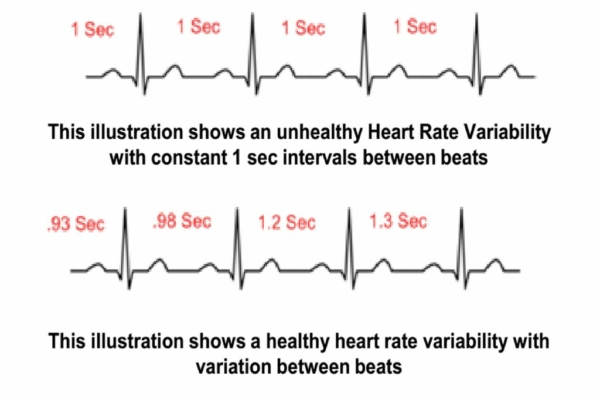What is Heart Rate Variability & How Can You Improve It with Velocity
by Denise – Thursday, 16. July 2020
What is Heart Rate Variability (HRV)?
As popular as the metaphor may be, a healthy heart doesn’t beat as regularly as a metronome. It actually changes its rhythm with each beat. This physiological phenomenon of constant variation in time between successive heartbeats is known as your heart rate variability (HRV). The time between beats is measured in milliseconds (ms) and is called an “R-R interval”. It is not to be confused with the heart rate which focuses on the average beats per minute.

Some situations result in an increase in variation (high HRV), while others cause the intervals between the beats to stay more constant (low HRV). You may not be aware of these subtle variations, but they reflect your heart’s ability to respond to different situations.
What influences HRV?
But how can we explain these changes in HRV? The HRV is linked to the autonomic nervous system (ANS) which regulates essential body functions like heart rate, respiratory rate, and digestion. It is subdivided into two systems-the sympathetic nervous system and the parasympathetic nervous system which function like a tug-of war game.
While your sympathetic nervous system is the driver of your activating (fight-or-flight response), the parasympathetic nervous systems kicks in during calmer moments as your rest-and-digest network. As for your heartbeat, your rest-and-digest tells your heart to slow down, making room for variability between beats (higher HRV) whereas your fight-or-flight system tells your heart to speed up, limiting space for variability (lower HRV).
Both systems dial their activity up or down based on messages from your brain and spinal cord. These systems can be active at the same time, or one can take over and dominate the other. By balancing these two forces the ANS helps you respond to daily stressors.
Since the ANS greatly influences how your heart beats the HRV is the most effective way of estimating your ANS balance.
As a rule of thumb:
- High HRV is associated with rest-and-digest, general fitness, and good recovery
- Low HRV is associated with fight-or-flight, stress, illness, or overtraining
Why is HRV a sign of fitness?
When you have high heart rate variability, it means your body is responsive to both systems (parasympathetic and sympathetic). This is a sign that your nervous system is balanced, and that your body is very capable of adapting to its environment and performing at its best.
On the other hand, if you have low heart rate variability, one branch is dominating (usually the sympathetic) and sending stronger signals to your heart than the other. There are times when this is a good thing for example if you’re running a race you want your body to focus on allocating resources to your legs (sympathetic) as opposed to digesting food (parasympathetic).
However, if you’re not doing something active, low HRV indicates your body is working hard for some other reason (maybe you’re fatigued, dehydrated, stressed, or sick and need to recover) which leaves fewer resources available to dedicate towards exercising and therefore performing at your best.
To look at it another way, the less one branch is dominating the other, the more room there is for the sympathetic (activating) branch to be able to come in and dominate, which is why high HRV suggests you’re fit and ready to go.
How can I improve my HRV?

That’s easy! By joining our spin or power classes! Recent studies show that regular exercise is one of the best methods for improving your heart variability. You will not only improve your cardiovascular system the release of endorphins during exercise will also make you feel energized and boost your self-esteem!
Exercising is just one thing you can do to increase your HRV. If you are keeping tabs on your overall health and well-being here are a few more things you can do:
- Good Nutrition at the Right Times. A smart and healthy diet will benefit your HRV, but also the timing of your food intake can affect it. Your body functions better when it knows what’s coming and regular eating patterns help maintain your body’s 24h-internal clock. In addition, not eating close to bedtime (within 3-4 hours) will improve the quality of your sleep by allowing your body focus on other restorative processes instead of digestion.
- Hydrate. Read our latest blog post “Don’t forget to hydrate!”
- Avoid Alcohol. Consuming alcohol makes your HRV drop by an average of 22 milliseconds the next day.
- Sleep well & Consistently. Getting a good night sleep is a good start, but making an effort to go to sleep and wake up at regular times each day is just as important! Sleep consistency will boost your HRV by helping to sustain your body’s 24h-interal clock, and also enables you to spend more time in REM and deep sleep.
- Natural Light Exposure. Going outside in the sunlight after waking up in the morning and watching the sky change from dark to light in the evening trigger biological processes involved with regulating sleep/wake times, energy levels and hormone production.
- Cold Thermogenesis. Exposing your body to cold temperatures for brief periods of time for example by taking a cold shower will stimulate the vagus nerve, which activates the parasympathetic branch of your autonomic nervous system and controls heart rate variability.
- Intentional Breathing. If you feel stressed slow, controlled breathing techniques can positively impact your HRV by inhibiting heart rate variability.
There are many things you can do to improve your HRV. If you haven’t already booked your next class at Velocity go ahead and do it now and make the first step to a healthier and stronger YOU!
References:
https://ouraring.com/what-is-heart-rate-variability
https://elitehrv.com/heart-rate-variability-vs-heart-rate
https://www.firstbeat.com/en/blog/what-is-heart-rate-variability-hrv/
https://www.whoop.com/thelocker/increase-hrv-heart-rate-variability/
https://www.whoop.com/thelocker/heart-rate-variability-hrv/



Meet the New Faces Behind Our Power Team
/in Health, Lifestyle, Living in Zug, Living in Zurich, Power/by Casey3 Ways to Push Through a Tough Workout
/in Health, Lifestyle, Living in Zug, Living in Zurich, Power, Rides/by CaseyMeet Your New Power Coach, Julia
/in Health, Lifestyle, Living in Zug, Living in Zurich, Power, Rides/by Casey